Whatever you’re looking for, a sales prospecting tool will help you do one or more of the following:
- Identify high-quality prospects.
- Qualify and prioritize these prospects.
- Find accurate contact data for your prospects.
- Engage with your prospects.
FYI: Sales Hub's Prospecting Tools identify key decision-makers for targeted outreach to improve conversion rates.
The Benefits of Sales Prospecting Tools
While sales prospecting can be conducted manually, sales prospecting and sales productivity tools provide unique advantages. See common benefits below.
You’ll boost sales prospecting efficiency.
In 2022, 29% of salespeople reported that improving sales process efficiency was their top goal, according to HubSpot research.
To create a more efficient sales process, teams need to focus on all stages of the sales lifecycle. That includes how prospects are identified.
Unlike manual prospecting, sales prospecting software allows you to quickly identify potential customers. You can automate parts of the search process to save time and resources.
Prospect and data quality will improve.
HubSpot’s 2022 Sales Strategy Survey found that 18% of salespeople cite a lack of high-quality leads as their top challenge. Your team may also struggle to find high-caliber prospects, which results in low-quality leads.
Even in instances where salespeople can identify interested customers, 19% of salespeople struggle with getting in direct contact with decision-makers.
Sales prospecting software solves both of these problems by helping salespeople find, qualify, and prioritize leads. Additionally, these solutions help teams find accurate contact data and manage outreach.
You can conduct sales prospecting at scale.
Meeting sales quotas is a top challenge for 20% of salespeople. In fact, 26% of salespeople only get between 1 to 10 new leads a week.
For most salespeople, exceeding this number is nearly impossible with manual prospecting.
When each stage of the prospecting process is automated (whether in part or fully), your tea can speed up the discovery, qualification, and outreach process. Many sales prospecting tools also provide access to prospect databases, which can be filtered and sorted based on your ideal customer profile.
Best Sales Prospecting Tools Comparison
|
Feature |
HubSpot Sales Hub |
LinkedIn Sales Navigator |
PartnerTap |
Apollo |
|
Key Features |
Automated prospect list building and real-time tracking, Custom views with filtering, Automated notifications for high-priority prospects and email sequences, Website visitor tracking |
Advanced search with filters, Custom prospect list building and management, Prospect update alerts (job changes), Personalized outreach via LinkedIn mail, Access to 875M LinkedIn members |
Co-selling, co-marketing, and lead-sharing with partners, Automatic data integration from CRM or CSV, Partner ecosystem connection at no cost to partners, Overlapping customer/prospect discovery, Full control over data sharing |
250+ million contact database with verified details, 200+ filtering attributes, Prospect monitoring, AI-powered “Persona Lookalike” suggestions, CRM integrations and Chrome extension |
|
Pricing |
Limited free version available Paid plans: $45/month (Starter), $450/month (Professional), $1,200/month (Enterprise) |
Core: $99.99/month ($959.88/year) Advanced: $139.99/month ($1,679.88/year) Advanced Plus: Custom pricing (starts ~$1,600/year) |
Free edition available, Custom pricing for enterprise features |
Limited free version available Paid plans start at $39/user/month |
|
Free Trial |
Yes (Limited free version) |
Yes (30-day free trial) |
Yes (Free edition available) |
Yes (Limited free version) |
The 29 Best Sales Prospecting Tools
Looking for a sales prospecting solution, but not sure where to start? Our team gathered 29 of the best sales prospecting tools on the market in 2025. Review key features and find out which will work best for you.
1. HubSpot Sales Lead Software
If you’re looking for a robust sales solution, consider HubSpot’s Sales Hub. Here you can both find prospects and leverage additional features to move them along the buyer’s journey.
Core features include:
- Automated prospect list building and real-time prospect tracking. This allows you to see which companies visit your website and what actions they perform on your site.
- Custom views. Here you can sort and prioritize prospects using filtering criteria. That includes sorting by the user’s number of visits, number of page views, location, and company size.
- Automations. This helps to ensure timely prospect engagement. You can set up automated notifications to alert your team when high-priority prospects engage on your site.
- Automated email sequences. This feature optimizes and boosts the effectiveness of your prospect outreach.
What we love: Aside from its powerful core prospecting features, HubSpot’s sales lead platform offers a comprehensive sales solution. And its Lead Management organizes prospecting activities on one centralized AI-powered workspace for maximum efficiency.
Pricing: A limited version is free as part of Hubspot’s Sales Hub. For more advanced functionality, HubSpot offers premium features in the Starter, Professional, and Enterprise versions of Sales Hub. Prices start at $45 per month, $450 per month, and $1,200 per month, respectively.
What Users Say
“The platform is easy to use and has an incredibly good customer service team to accompany it. I spend around two hours a day using the sequencing tool to prospect and have never had any issues. We also use it as our CRM, which does exactly what we need it to. Recommend to any size organization,” Sam H. for G2.
2. LinkedIn Sales Navigator

LinkedIn has a huge global user base of 875 million members. Of this user base, many are high-income earners that are currently “in the market” to buy products. Additionally, nearly 16 million of these people hold ownership or senior C-suite positions within their organizations.
LinkedIn Sales Navigator is a sales tool that’s designed to help you engage with prospects on this powerful platform.
Core features include:
- Advanced search capabilities, which leverage filters such as job titles, organization size, and company.
- Custom prospect list building and management. Here you can take notes and gets alerts about relevant prospect updates, such as job changes.
- Personalized prospect outreach via LinkedIn mail.
What we love: LinkedIn Sales Navigator has the ability to tap the most important social media platform for B2B businesses. Here you can find prospects with precision and ease.
Pricing: Available upon request.
What Users Say
“What I like the most about LinkedIn Sales Navigator is the amount of information that you can find about any person or company’s profile without number limitations, including different filters to select the information that you want and what is relevant for you,”Nicolas G. for G2.
3. PartnerTap
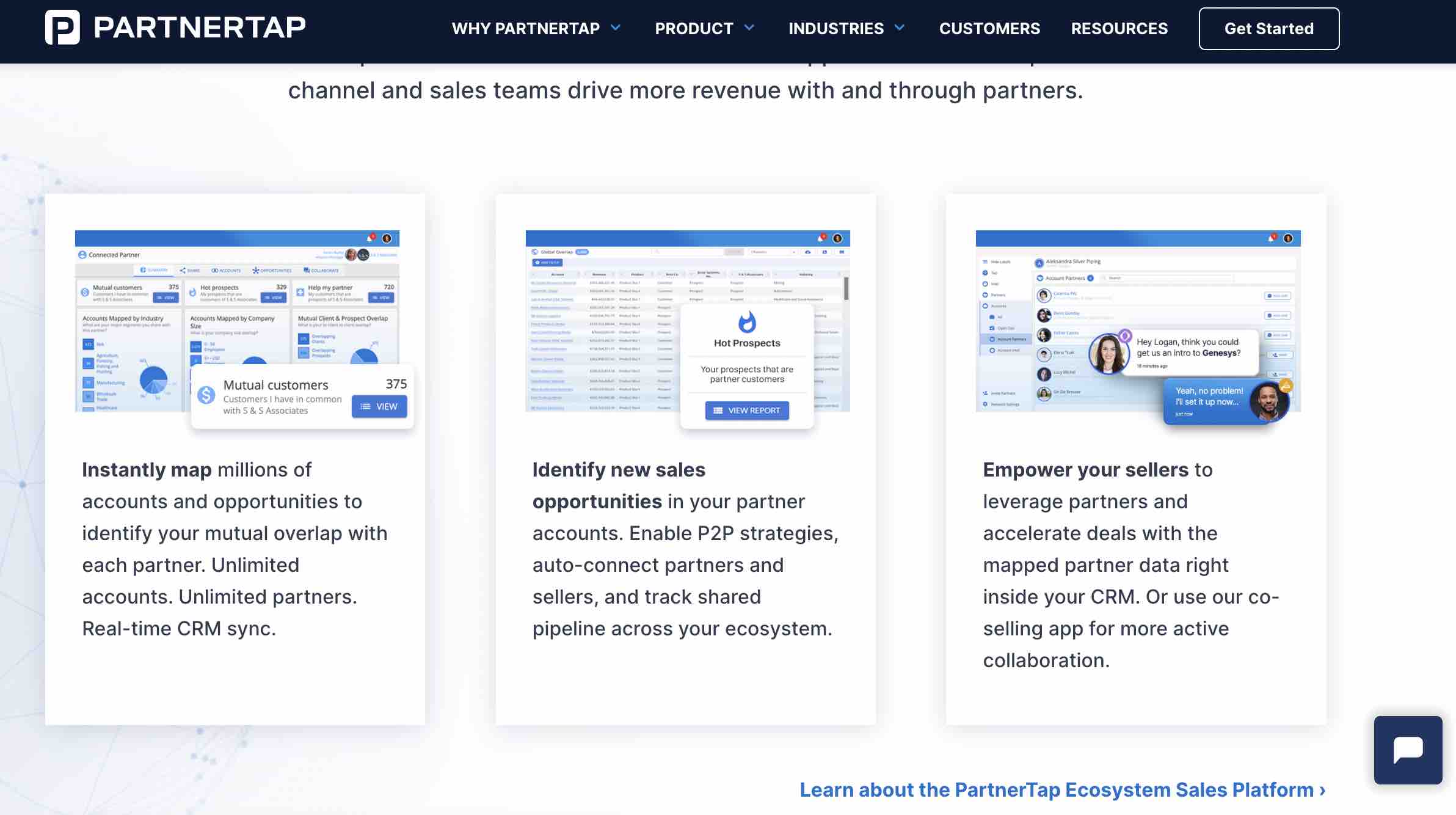
If you’re looking to leverage your ecosystem, PartnerTap may be the solution for you. This enterprise solution enables “co-selling, co-marketing, and lead-sharing” among business partners.
This works via a simple three-step process:
- You sign up for the platform.
- Your data is automatically pulled from your customer relationship management system (CRM) or a CSV file.
- You then invite your partners to connect on the platform at absolutely no cost to them.
Once you’ve done this, PartnerTap allows you to uncover overlapping customers, prospects, and opportunities within your ecosystem. That includes prospects that are current customers of one or more of your partners.
Plus, you (and your partners) have full control over what and how much data you share.
What we love: For many salespeople, partners are often an untapped or underutilized prospecting resource. PartnerTap provides a non-competitive, mutually beneficial system for uncovering opportunities throughout your partner ecosystem.
Pricing: Available upon request.
What Users Say
“Well-organized and intuitive — time is gold in sales, and sales enablement tools need to provide quick returns with limited effort … [I] have never used another sales tool that does this better,”Nick L. for G2.
4. Apollo
Apollo is a sales intelligence and engagement platform that enables prospect discovery, outreach, and management. The platform’s engagement features (especially those that leverage automation and AI) are incredibly powerful.
Core features include:
- A prospect database of over 250 million contacts, including verified phone numbers, email addresses, and job titles. These prospects can also be filtered using 200+ attributes.
- Prospect monitoring functionality. This alerts you of job changes, funding news, and hiring decisions.
- Artificial Intelligence (AI). This allows you to use the “Persona Lookalike” functionality that suggests prospects based on your ideal client persona.
What we love: Apollo has multiple integrations. Not only can you integrate your CRM, Apollo also has a Chrome extension that allows you to find contact details of LinkedIn connections.
Pricing: Limited versions are available for free. For more advanced functionality, paid plans start at $39 per user per month.
What Users Say
“The best thing I like about Apollo is being able to find almost all the emails of the decision-makers I need to contact… I also like how integration with HubSpot works so that I don’t need to do the double work by adding the leads to both systems separately (+ email tracking is great too),”Kate K. for G2.
5. Salesflare

If you’re selling to businesses (B2B) and want a complete sales prospecting solution, then Salesflare may very well be what you’re looking for.
Core features include:
- A robust LinkedIn integration. You can add leads straight from LinkedIn, find their email addresses, and easily enroll them in an email sequence.
- Email campaigns and sequences. This helps you automate your outreach and follow-up emails, so you don’t have to send a lot of emails manually. Works seamlessly with Google Workspace and Microsoft 365.
- Automated data enrichment. This feature enriches your leads automatically with data from LinkedIn and other publicly available sources, as well as from email signatures.
- Add leads from anywhere with the Chrome extension. Just open up the extension on any website and find the right contact person, including their contact information.
What we love: Salesflare is not just a sales prospecting tool. It’s a comprehensive sales CRM software that is simple to use and easy to keep up to date, so you can turn all these leads into deals.
Pricing: Salesflare offers three pricing plans: the Growth, Pro and Enterprise plan. Prices start at $29 per user per month, $49 per user per month, and $99 per user per month, respectively.
What Users Say
“First time my sales team said “I love the CRM” - something I had never heard before.” Steve B. for G2.
6. Cognism

Cognism is a compliant global sales intelligence platform that equips B2B revenue teams with a suite of tools to find, engage, and convert ideal prospects faster. The suite includes:
- Sales Companion (Web App & Browser Extension): A next‑generation, AI‑powered sales platform—tailored for each seller and leader. It delivers personalized dashboards, intelligent lead recommendations, and real‑time signals to hyper-personalize outreach at scale.
- Diamond Data®: Phone‑verified B2B mobile numbers to connect you with 87% of your list, manually validated and continuously refreshed for higher connect rates.
- AI Search & Research Tools: Use ChatGPT‑style text or voice prompts to instantly build ICP‑aligned lists—no complex filters required.
- Rich Signal & Technographic Data: Track intent trends, hiring news, funding events, technology stacks, and breaking insights to engage at the right moment.
- Instant & Scheduled Enrichment: Automatically update CRMs or CSVs with enriched, verified contact data via API or batch, keeping records fresh.
- Seamless Tech‑stack Integrations: Direct syncing with HubSpot, Salesforce, Pipedrive, Salesloft, Outreach, and more, built into both Grow and Elevate plans (no additional integration fees).
Why we recommend it: Cognism stands out from other tools in this category with it’s automated compliance, accurate data and AI-powered tools.
Pricing: Available upon request.
What Users Say
“I use Cognism pretty much every day for prospecting, outreach, and monitoring intent data. The biggest attraction of the platform for me is that it is the only solution that effectively covers both of our core markets (the US and the UK). I have found the quality of data in the US to have been excellent in the past 12 months, and this has helped to lift our connect-to-dial rate considerably,”Humphrey C. for G2.
7. Wiza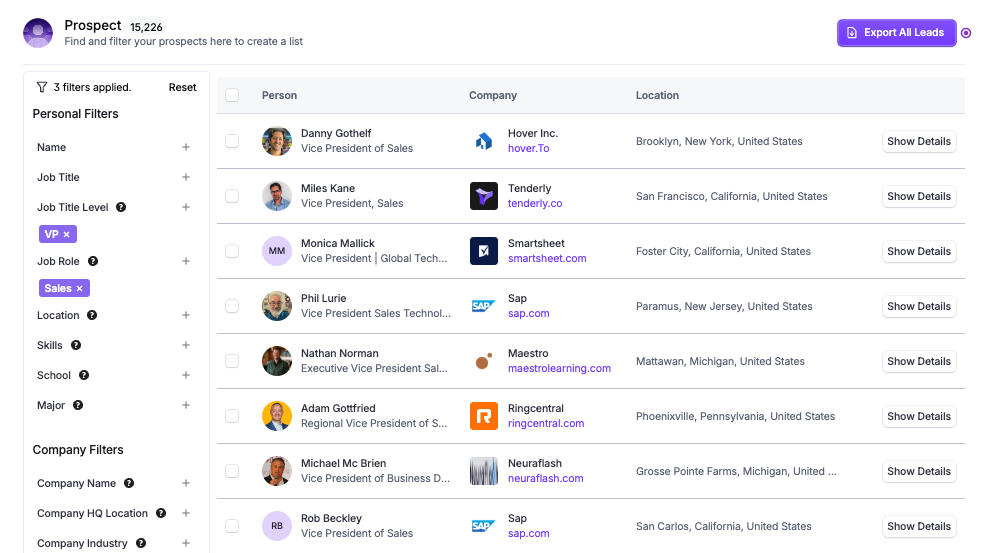
Wiza is a sales prospecting tool for sales, marketing, and recruiting professionals. It provides a large, searchable database of B2B professionals that can be filtered by both personal and company filters like name, job title, and industry and offers real-time verified contact data like email addresses and phone numbers to power your outreach.
Core features include:
- Over 830 million contacts, including verified email addresses, phone numbers, and current job titles.
- Ability to export up to 10,000 leads at a time as well as send contact information directly to CRMs like HubSpot, Salesforce, Outreach, and more.
- A free chrome extension that enables you to view contact data on LinkedIn and export in bulk via LinkedIn Navigator and LinkedIn Recruiter.
What we love: Wiza verifies all contact data in real-time, ensuring you have the most accurate contact information available for your outreach.
Pricing: Wiza offers a free version including 25 email and phone credits to start. For more advanced usage and functionality, paid plans start at $25 per month.
What Users Say
“Wiza is an amazing tool that offers a business solution by providing email contacts that are otherwise difficult to find. It increases my marketing productivity by offering accurate results that lead to proper sales leads.”J. Michael W. for G2
8. Crunchbase
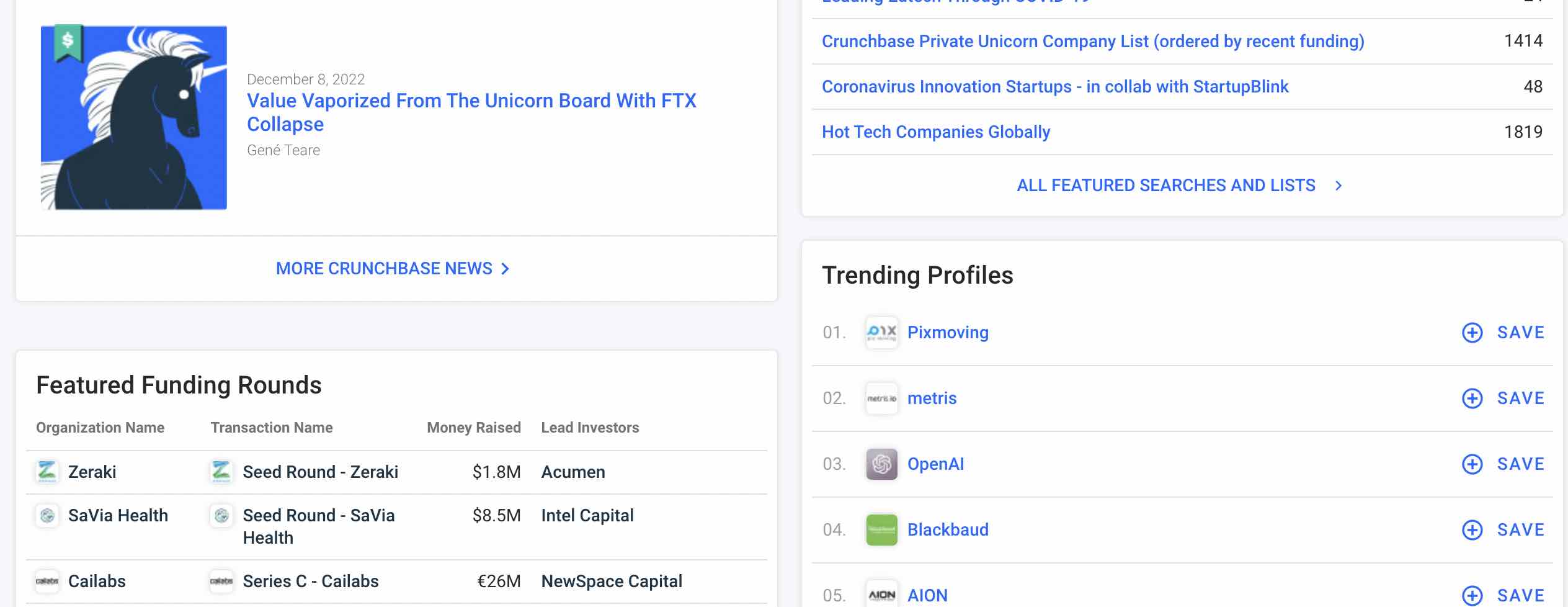
Crunchbase is a company database that collects insights on private and public companies. Here you can filter prospects based on company, investor, and funding data. Crunchbase also gathers the latest news on the companies you track.
Core features include:
- Access to verified contact data. You can also connect with contacts from within the platform.
- Account recommendations based on predefined criteria.
- Market monitoring. This helps you to recognize industry trends early, track buying signals and identify trigger events.
What we love: With Crunchbase, you can access and monitor key financial data and insights that indicate buying power and readiness. That includes news related to funding, information about funding type, and who financial backers are.
Pricing: A limited version is available for free. For more advanced functionality, paid plans start at $29 per user a month.
What Users Say
“Great source of research for sales pros looking to get additional information on prospects and relevant news on your clients. It is a great tool if your account base includes startups! Information on VC’s funding and investors and recent deals can [be] very helpful in understanding your customers,”Donald B. for G2.
9. CIENCE GO Data
GO Data by CIENCE is an advanced tool for sales intelligence, housing more than 200 million records that are regularly validated and updated for precision. The platform simplifies the list-building process with its user-friendly interface and allows for virtually limitless configurations of Ideal Customer Profiles, which can be assembled within seconds using the SCIENCE Go Data builder.
As one of the world's largest outbound services companies, its extensive network usage contributes to minimizing data decay by facilitating regular use and updates. Data compliance is a priority for CIENCE, as they regularly cross-check mobile numbers with global Do Not Call lists, validate emails, and ensure all data handling aligns with B2B data best practices and country laws.
CIENCE GO Data stands as a reliable tool for sales reps, business development departments, customer data analytics, and account-based marketing (ABM) teams. With its extensive features and competitive pricing model, GO Data offers a unique, data-driven strategy for businesses of all sizes and industries.
Core features include:
- Advanced search capabilities, leveraging filters such as job titles, seniority level, organization size, industry, revenue, and company.
- Custom ICP (Ideal Customer Profile) and account list building and management. GO Data enables you to configure and manage target profiles while being notified of updates, such as job changes.
- Precision targeting of prospects with the ability to directly access their validated contact information for personalized outreach.
What we love: CIENCE GO Data empowers B2B businesses with unparalleled access to a rich, validated contact database. Here, you can locate and engage your prospects with precision and ease.
Pricing: Available upon request.
What Users Say
“The power of the platform is limitless. With all the data – sales, prospects, contracts and account information side by side in one place it means we can target a campaign and know exactly where to go with it, saving time and money. I am so relieved now that we have this data. It's been a Godsend!” Theresa Y. for Sourceforge.
10. Usergems

Usergems is a sales intelligence platform that offers two powerful sales prospecting solutions: account tracking and contract tracking.
Account tracking allows you to monitor relevant job changes within target organizations. You can also access verified contact data and identify previous “touch points” within the organization.
Contact tracking focuses on job changes for prospects, users, leads, and former customers. Every time a former lead or customer moves to a new company, it provides an opportunity to pitch your product or service to that new organization through a warm introduction.
What we love: Not only does Usergems alert you when a former lead or prospect leaves their company, the platform also adds them to your CRM as a new contact (with their new information).
Pricing: Available upon request.
What Users Say
“It’s opened up a new customer base for us to target and prospect. It’s user-friendly and has been straightforward in receiving the leads,”Hannah H. for G2.
11. Leadfeeder
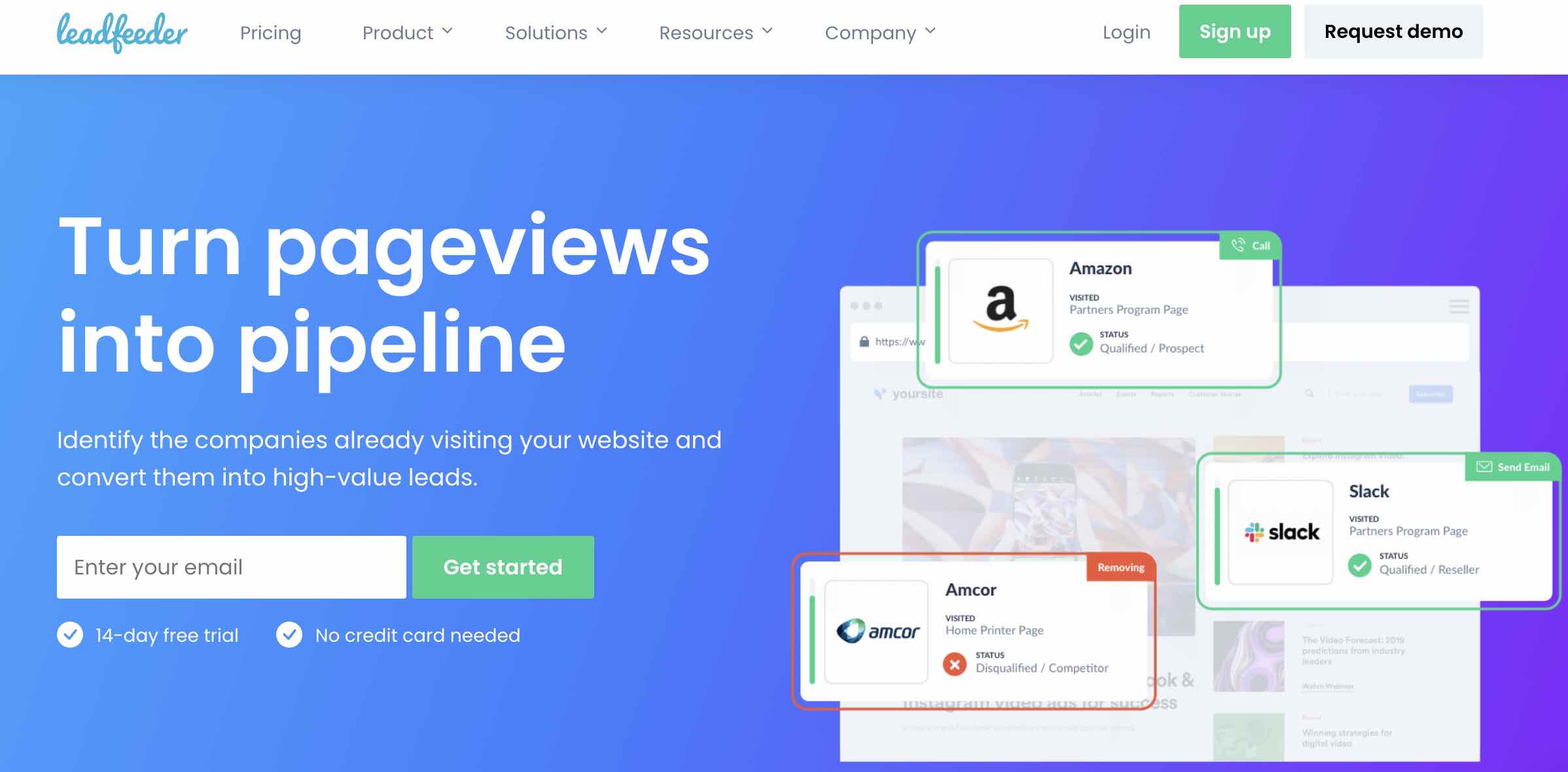
Leadfeeder is a B2B lead generation software that uses a tracker script to help you identify and monitor website visitors.
Using Leadfeeder you can:
- Identify the companies that visit your site.
- Monitor prospect behavior while on your site.
- Score and qualify prospects based on their activity on your site and demographic filters.
- Set up email alerts based on predetermined criteria, such as “when X company visits your site.”
- Integrate with your CRM for data enrichment.
Leadfeeder also provides a filterable contact database, which allows you to contact and engage with relevant leads.
What we love: Prospects that visit your website have already shown some form of interest in your product or service. This makes them more likely to engage and convert during the outreach stage. With Leaderfeeder, you can identify people who are most likely to buy.
Pricing: Limited version available for free. For access to more features, paid plans start at $79 per user a month.
What Users Say
“Leadfeeder gives us a great idea of which qualified enterprise prospects are checking us out so we can follow these leads,”Ben O. for G2.
12. Snov.io
Snov.io is a comprehensive prospecting and outreach platform that helps teams discover high-quality leads, find and verify emails, run multichannel sequences (email and LinkedIn), and track campaign results, all within one smart ecosystem.
Here are some core features:
- Database with over 50 million company contacts.
- Email Verifier tool that offers a 7-tier verification process with MX record checks, accurate SMTP pings, and greylisting bypass for extra hard cases.
- LinkedIn Email Finder extension that allows you to scrape emails from LinkedIn, and the Email Finder extension that enables you to collect high-quality emails anywhere on the web.
What we love: You get prospecting, verification, deliverability, and multichannel outreach under one roof, helping you save your budget and get maximum results.
Pricing: A free trial plan is available. Paid subscriptions start at $39 per month.
13. Owler Max by Meltwater
Owler Max by Meltwater offers several features that are helpful for prospecting and lead generation. These features enable sales professionals to identify and qualify potential prospects more effectively.
Here are some key Owler features that support prospecting:
- Company Profiles: Owler provides detailed company profiles that include information such as key executives, funding history, employee count, and competitive landscape.
- Funding Insights: The tool provides information about funding rounds, investments, and financial details of companies.
- News and Alerts: Owler delivers real-time news updates about companies, industry trends, and events.
- Competitor Analysis: The software allows sales professionals to conduct competitor analysis.
- Community Insights: Owler has an active community of contributors who share information and insights about companies. Sales professionals can tap into this collective intelligence to gather valuable prospecting insights, such as customer reviews, product feedback, and industry trends.
What we love: The software company belongs to big media intelligence player Meltwater, so customers can easily upgrade to a full-rounded suite to streamline their prospecting efforts, identify qualified leads, personalize their outreach, and stay informed about industry trends.
Pricing: Available upon request.
14. Mixmax
Mixmax is a sales engagement platform designed to streamline and optimize the sales process for SDRs, AEs, and CSMs. With its user-friendly interface and AI-driven automation, Mixmax enables multi-channel prospecting, allowing sales teams to connect with leads across different platforms, book more meetings, and close more sales.
Core features include:
- The ability to create multichannel prospecting sequences including emails, call tasks, LinkedIn connection requests, DMs, and SMS.
- AI-powered email personalization tools that help users craft personalized emails and optimize send times, improving open and reply rates.
- Automatic syncing with Salesforce and HubSpot to ensure all communications and activities are logged, reducing manual data entry and maintaining up-to-date records.
- Automation tools that allow users to set up rules and triggers based on recipient actions, ensuring timely follow-ups.
- Email enhancements like in-email polls and surveys, one-click calendaring, embedded CTA buttons, link previews, and more to help sellers stand out in a crowded inbox.
What we love: Mixmax integrates with Gmail, Outlook, Salesforce, and HubSpot, making it easy for sales teams to adopt and use without needing to switch between multiple tools. The AI features for email personalization and timing are particularly valuable for boosting open and reply rates.
Pricing: Mixmax offers a range of pricing plans, starting with a free version. Paid plans with more advanced features start at $29 per user per month.
What Users Say
“Mixmax is my sales engagement tool of choice because it's simple enough to set up in an afternoon. But powerful enough to support your entire sales org. You won't find a tool that works more seamlessly within your email service provider and lets you do exactly what you want to do more of: make calls, send emails, and engage on LinkedIn.” — Jason Bay, Founder & CEO at Outbound Squad
15. Pipedrive

Pipedrive is a sales CRM that offers powerful sales prospecting features so you can manage every part of your sales process in one tool.
Store new leads in the Leads Inbox until you’re ready to qualify them. Prioritize the biggest opportunities and next best actions by filtering, sorting and editing your leads. Missing valuable information about a lead? Pipedrive’s Smart Contact Data feature lets you use a contact’s email address to collect data they share online with just one click.
The LeadBooster add-on has four powerful prospecting features to help you capture new leads, including a website Chatbot that can loop in your sales reps and web forms you can share or embed into your website.
Once you’ve captured a lead, our automatic assignment feature allocates the lead to the right sales rep, based on the rules you’ve created.
What we love: Pipedrive enables you to visualize your entire selling journey, so you can nurture leads from acquisition all the way to purchase.
Pricing: Pipedrive costs between $14 and $99 per month when paid annually, depending on which plan you choose.
What Users Say
“I love how streamlined Pipedrive actually is. Everything is practically integrated. Emails synchronize and link with existing leads. Leads can be easily turned into deals. Contracts can be executed within the workflow. Lead activity takes no time to complete. It’s been refreshing using Pipedrive versus other CRMs I have worked with in the past.” Chris C. for G2.
16. Bombora
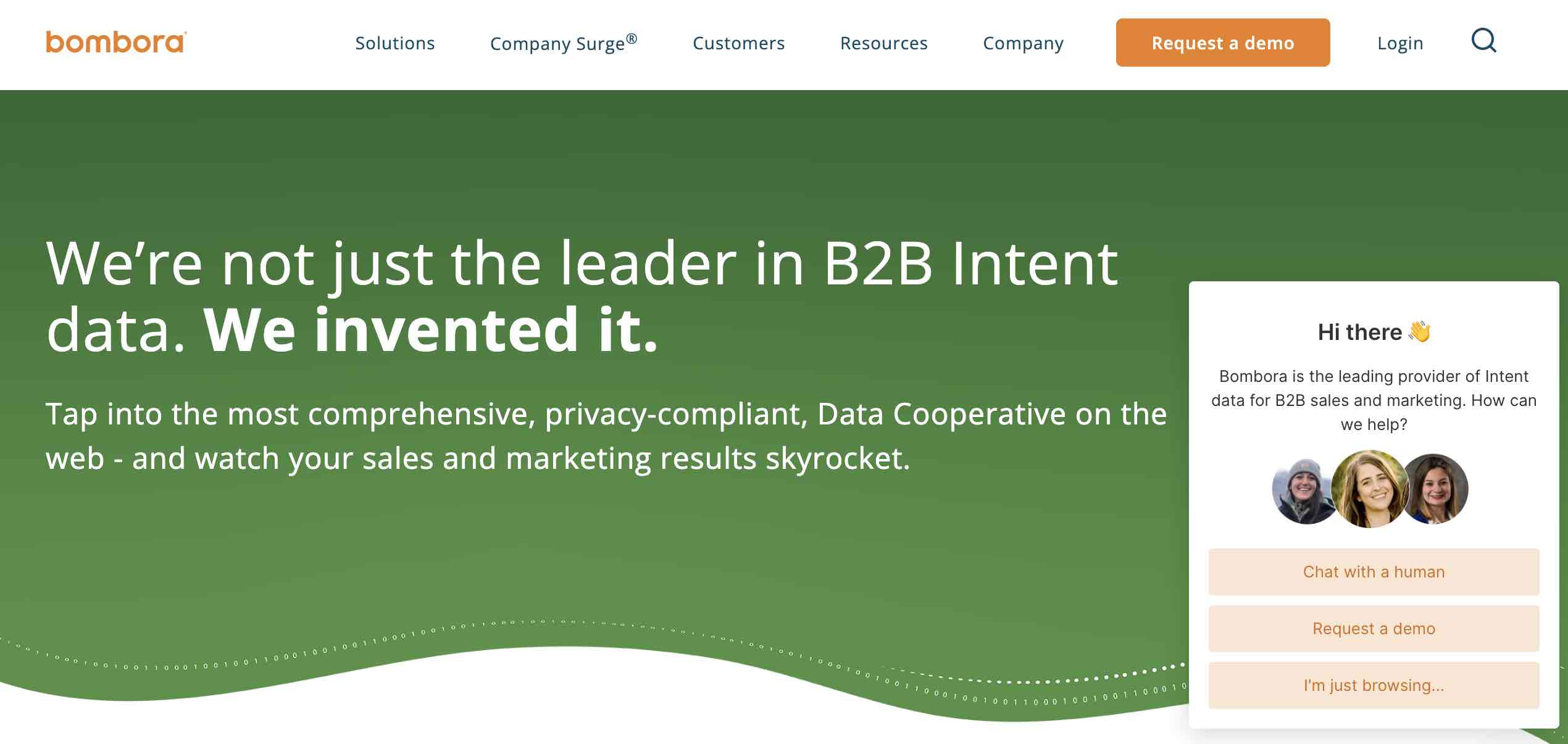
Bombora Company Surge is a software platform that helps users access and monitor intent data. To do this, Bombora collects data from a consent-based data cooperative of B2B publishers. The platform then analyzes this data using machine learning and maps the data to specific businesses.
This data can then be used to:
- Score and prioritize prospects based on “readiness” or interest.
- Plan timely and relevant prospect outreach and follow-up.
- Identify “at-risk” accounts by seeing if prospects are also researching competitors.
What we love: Bombora allows you to set up “automatic surge reports” that periodically populate your CRM with prospects who have shown buying intent.
Pricing: Available upon request.
What Users Say
“The platform is incredibly intuitive, and the user experience is easy to use. My favorite part of the tool is the automatic surge report and net-new account to HubSpot,”Ashden K. on G2.
17. UpLead
UpLead is a platform that offers users access to a suite of sales prospecting products. That includes three important features:
- The prospector. UpLead’s prospector provides access to a database of over 100 million contacts. This database is filterable using 50+ search criteria such as industry, title, and location. Select prospects can then be pushed directly into your CRM.
- Email verification. The platform conducts an instant verification procedure to ensure accuracy.
- Data enrichment. UpLead users have the option to upload a prospect list. The platform then automatically enriches each prospect with over 50 data points.
What we love: UpLead uses a pay-as-you-go system, which makes it a more affordable solution for most salespeople. Users purchase “credits” that can then be used to download or export contacts.
Pricing: A limited version is available for free. For access to more features, paid plans start at $74 per month.
What Users Say
“The leads on UpLead are more up-to-date; I get leads with higher quality. That’s more important to me than the largest database because I know for sure that the email will get through… It’s affordable and worth it,”Julia K. for G2.
18. HG Insights
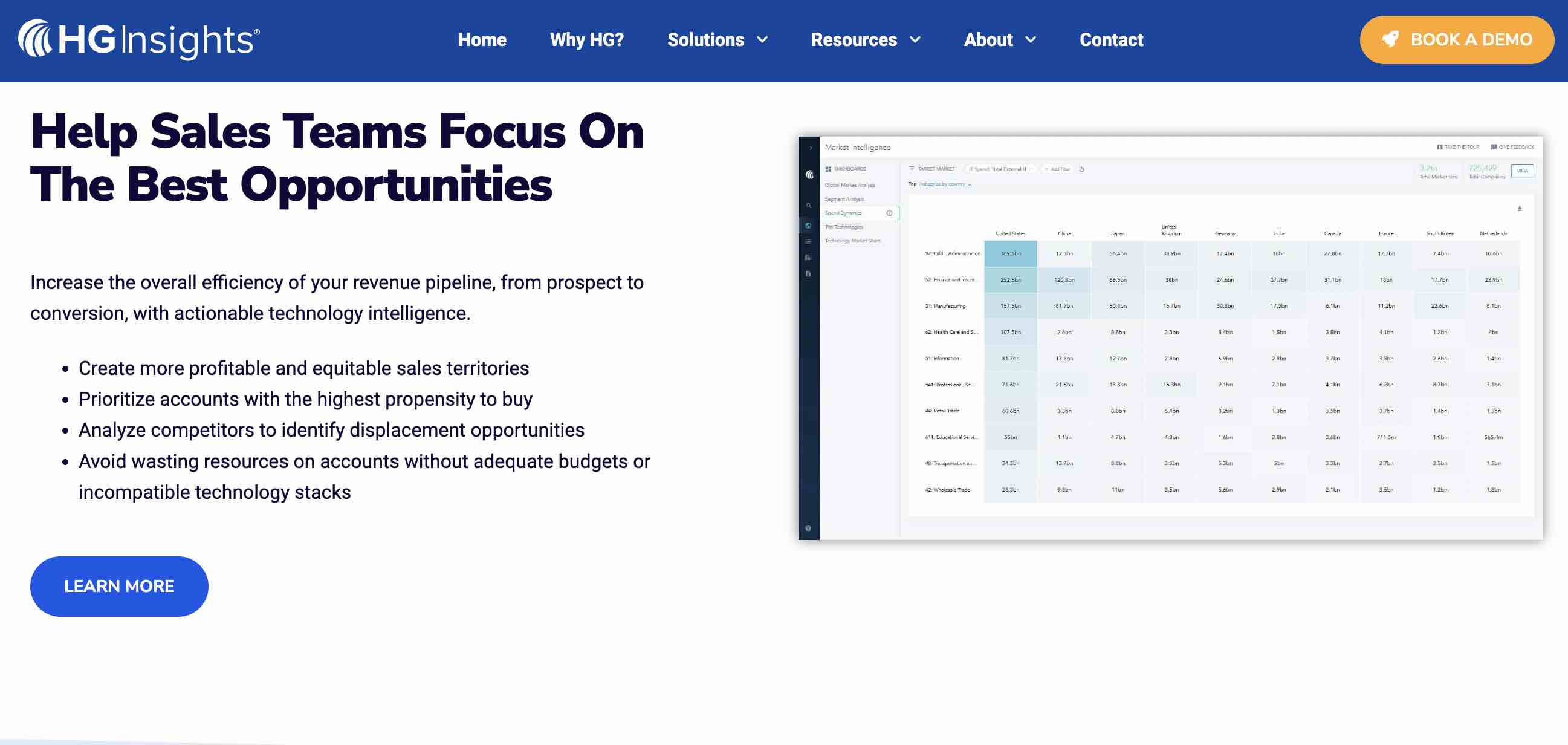
HG Insights is a market intelligence platform. Specifically, this platform monitors the “digital infrastructure” of over 9 million companies and uses this data to produce actionable insights for sales teams.
Here are some of the things you can do with HG Insights:
- Monitor and analyze your overall market. This can be used to estimate “vendor penetration” and identify opportunities in underserved markets.
- Identify high-quality prospects. These are prospects that are likely to buy your product based on factors such as the current tech stack and usage data.
- Leverage “contextual intent data” for prospect qualification, scoring, and prioritization.
What we love: HG Insights is an especially powerful tool for software companies because the platform focuses heavily on “technographic” data. Here, you’ll find out which companies have installed certain technologies. This can help you narrow your pool of prospects.
Pricing: Available upon request.
What Users Say
“This tool is pretty neat. With a click of the button, you’re able to find what software stack other companies are using — which is especially useful when you’re in sales looking to find target companies by systems used,”Nikko J. for G2.
19. TechTarget’s Priority Engine
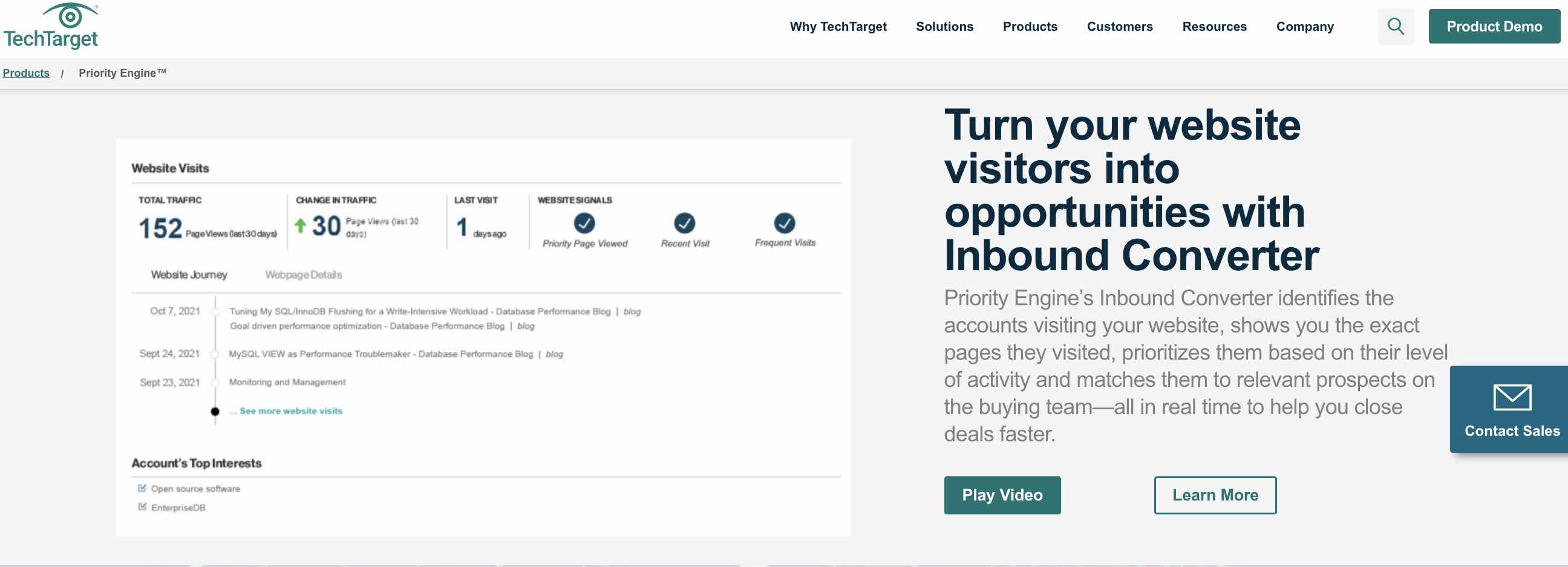
TechTarget’s Priority Engine is an intent data platform that helps users engage with prospects in their technology category.
Core features include:
- Identifying in-market prospects and building prospect lists based on intent data.
- Qualifying and scoring prospects using behavioral data. This data is also useful for understanding the buyer journey.
- Optimizing prospect outreach and improving response rates. Priority Engine uses AI-powered lead generation and intent data insights to aid in the process.
What we love: TechTarget highlights high-quality leads. These prospects have been triple-verified and shown significant interest in your solution by conducting relevant research with TechTarget.
Pricing: Available upon request.
What Users Say
“It is easy to filter on specific events like viewing our website/content, their interests, and other attributes that we look to go after for specific campaigns. The click-to-add feature is a really easy way to send contact information directly to our CRM,”Christina L. for G2
20. Demandbase
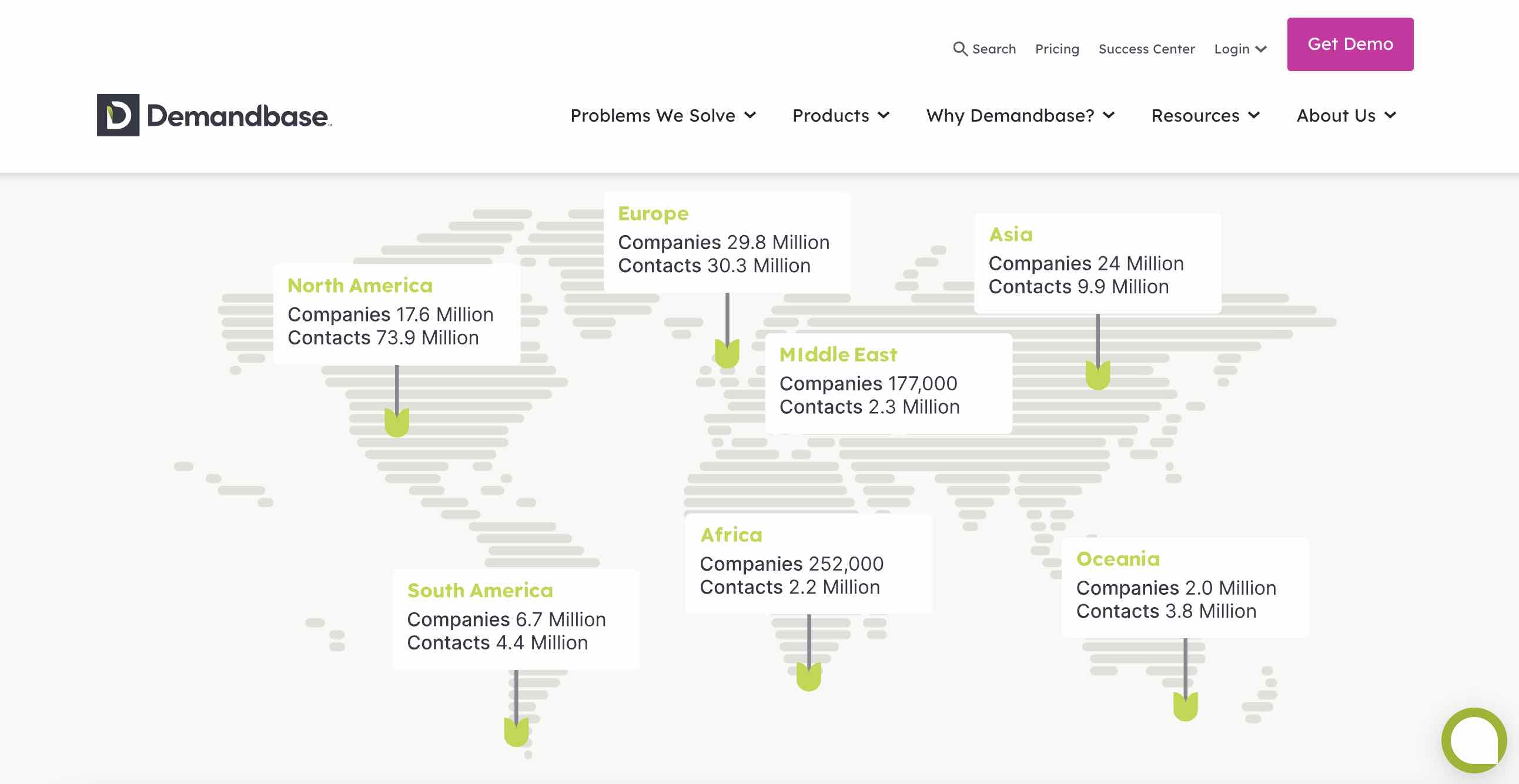
Demandbase is an account-based marketing (ABM) solution that offers a suite of intelligence solutions. The program works by taking first-party data from your data sources (CRM, website, etc.), matching this data with information from third-party sources, and then analyzing the resulting data to draw insights.
Here are some of the data and insights you can access from Demandbase:
- Company data. This includes data such as location, revenue, and number of employees.
- Contact data. This database includes email, LinkedIn, and phone numbers for over 113 million contacts with decision-making positions within their organization.
- Intent data. Demandbase’s intent data leverages data science to determine and score buying intent based on the prospect’s search activity.
What we love: Demandbase allows you to qualify, filter, and score prospects using intent data in various ways. For example, you can score based on what they viewed on your site or how long they spent on your site.
Pricing: Available upon request.
What Users Say
“What I like best about Demandbase is that it helps me identify potential customers and partners based on website visitors. It’s allowed me to target new prospects with even a tiny amount of interest that I wouldn’t have otherwise identified,”Amanda S. for G2.
21. Bookyourdata
Bookyourdata is a real-time B2B contact database platform built for sales and marketing teams that need verified, accurate business emails — fast. Instead of scraping or generating leads over time, users can instantly filter and download targeted contact lists from a global database, allowing users to:
- Build prospect lists using 100+ filters, including job title, location, company size, and industry.
- Access real-time verified contact data, ensuring reduced bounce rates and better deliverability.
- Preview contacts before purchase, allowing you to pay only for what you need with no subscription required.
- Download CSV-ready files instantly, ready for uploading to your CRM or outreach tools.
What we love: Bookyourdata offers a simple, scalable way to get valid email lists without committing to monthly plans, making it ideal for teams with flexible prospecting needs.
Pricing: P Pay-as-you-go at $0.40 per contact.
What Users Say
“We switched to bookyourdata after bit of deliberations as we don’t always need leads in bulk, so being able to buy just what we need is really useful. We found them best providers for email list. Also, the interface is clean and easy to get around. The leads data is fresh, and the export process is fast.” Joyce Heide F. for G2
22. Vainu
-jpg.jpeg)
Vainu is a B2B business database and sales intelligence software. Core features include:
- Company profiles. This allows users to filter through a database of millions of companies and identify prospects that fit their ideal customer profile. These profiles also include contact details such as emails and phone numbers.
- Workflow triggers: This allows users to enable automation. These trigger points can be used to build prospect lists based on predefined criteria.
- Artificial intelligence. This helps users identify buying windows and make prospecting suggestions.
What we love: Vainu allows easy access to data and straightforward integration with multiple platforms. One of the top reasons Vainu users love the platform, besides its functionality, is that it is incredibly easy to use.
Pricing: A limited version is available for free. For access to more features, paid plans start at €6,600 per year with a one-time onboarding fee.
What Users Say
“I like the company’s 360-degree view a lot. It saves us a lot of time in the prospect research phase,”Pernilla C. for G2.
23. Tami
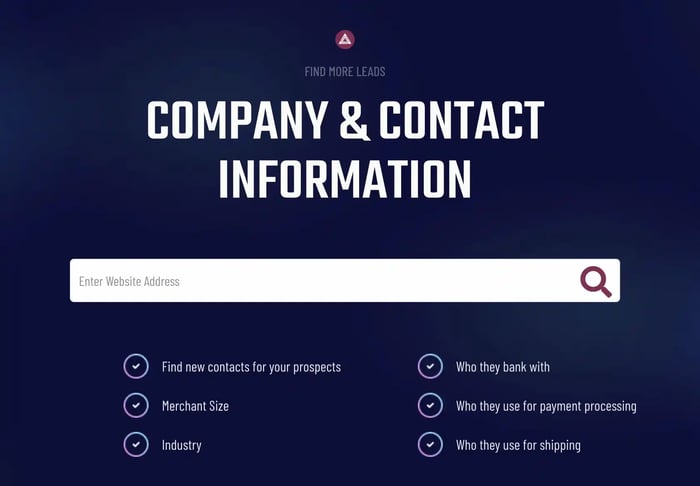
Alt text: sales prospecting tools, Tami dashboard
IMG name: sales-propsecting-tools-tami
Tami allows users to build prospect lists from profiles in its extensive database. This database can be filtered using multiple conditions, including geographical area, merchant size, company type, and even by which bank the prospect uses.
You can also access verified emails for decision-makers within their target organizations. And if contacts switch jobs, you can set up alerts to keep you up-to-date.
What we love: With Tami, users can skip the gatekeepers and go straight to the correct points of contact.
Pricing: Available upon request.
What Users Say
“You don’t have to waste your time with gatekeepers; you can find contact details of specific people to help focus your time,”Gareth D. for G2.
24. Hunter

Hunter is a platform for accessing verified and accurate professional email addresses. Plus, results in Hunter are returned with a confidence score, which indicates the estimated level of accuracy of the email address.
Core features include:
- Domain search. This allows users to find the email addresses of all users linked to a specific domain.
- Email finder. This allows you to find a professional email address using the prospect’s name and the company’s website domain.
- Email verifier. This tool allows users to verify the validity of an email.
What we love: Hunter makes finding contact information incredibly easy — even for users that have very little information to go on.
Pricing: Hunter provides a free version of the platform, which allows users to conduct up to 25 searches per month. Paid plans start at $49 per month.
What Users Say
“Hunter has a simple system to instantly generate contact information for leads…all I need to do is enter the domain for the company I’m searching for and the name of the contact, and it generates the email,”Jacob U. for G2.
25. Groove.co

Groove is a comprehensive sales engagement platform for Salesforce. Core features include:
- Multichannel campaign automation. Groove allows users to automatically import prospects into automated, multichannel flows and sequences. Users can also A/B test sequences and templates.
- Call automation and optimization. Groove provides a desktop app, the OmniDialler, that allows you to make calls within the app or from any webpage. You can also surface relevant information before or during calls.
- Online meeting scheduling. Groove offers users access to a customizable meeting-scheduling tool that allows users to schedule emails.
What we love: Groove is an especially powerful tool for email outreach and activity tracking.
Pricing: Available upon request.
What Users Say
“When you think about what you need when making sales in an online environment, Groove has everything, from booking appointments to automatic responses to follow-up emails, to read status. I love this tool and can’t imagine doing my job without it,”Mariana A. for G2.
26. Reply.io
Reply.io is a sales engagement platform that helps you streamline and supercharge your sales outreach with a mix of automation and AI. No matter if you're trying to generate leads, connect with prospects, or close deals, Reply.io has the tools you need to make it all happen more efficiently.
If you’re managing multiple communication channels and need a tool that simplifies the process, Reply.io is designed for you. It’s also well-suited for agencies that handle outreach for multiple clients and require a robust, scalable solution.
- Automatically reach out to prospects across email, LinkedIn, calls, SMS, and WhatsApp, so you're always where your prospects are.
- Let AI SDR Agents handle the repetitive tasks like sending messages and scheduling meetings, giving your team more time to focus on closing deals.
- Engage website visitors with a sales-trained AI Chat featuring video avatars. This chatbot captures leads and books meetings directly within the chat.
- Tap into a huge database of over 140 million verified contacts, ensuring your outreach is always targeting the right people with the most current information.
- Get your emails into more inboxes with unlimited mailboxes, and features that help warm up your email accounts, avoid spam filters, and improve overall deliverability.
What we love: Reply.io is a smart platform that helps you do more with less effort. The AI features take a lot of the manual work off your plate, and the multichannel approach ensures you’re connecting with prospects wherever they are.
Pricing: The basics start at $49/month for email automation and everything you need to start, like free warmups and unlimited mailboxes. If you need something custom, like AI SDR or agency-specific features, they’ve got options for that too.
What Users Say
“The multichannel sequences work perfectly, and integration with CRM (I'm using HubSpot) works well. If someone opts out, Reply immediately change the status for this lead, and stop sending emails to them. PLUS, the feature to find new leads and emails is super useful.” Viktoriia S. for G2.
27. Close

Close is a comprehensive CRM for small-business sales teams. To use this platform, you’ll need to first import your prospect list into the CRM. This list can then be filtered using search tools and smart views.
Here are some of the things you can do with Close:
- Automate cold calls through predictive dialing and leveraging Close’s “Power dialler.”
- Sync your existing email provider to receive and send emails within the CRM.
- Set up automated, customized, and personalized email sequences.
Aside from these features, Close also offers additional features specifically for sales leaders such as reporting and call coaching.
What we love: Close allows you to manage and automate almost all aspects of your prospect outreach and engagement without having to leverage any add-ons.
Pricing: Prices start at $29 per user a month.
What Users Say
“I would find that I would meet with prospects and when I couldn’t close on the first or second meeting, I would move on to the next prospect. Close has given those types of prospects new life by reminding me about not only the prospect but what the potential and eventual client and I spoke about, giving me an edge that I did not have before,”Tim M. for G2.
28. Lead Forensics

Lead Forensics is a powerful B2B lead generation software that provides businesses with the tools they need to turn website visitors into sales leads. Lead Forensics uses IP tracking technology to identify the companies that visit your website, even if they don't fill out a form or leave any contact information.
With Lead Forensics, you can:
- Identify the companies that visit your site, including contact details for key decision-makers.
- See which pages your prospects are visiting and how long they're spending on each page.
- Score and prioritize leads based on their activity on your site and other demographic and firmographic data.
- Integrate with HubSpot for easy lead management.
- Set up instant alerts to reach out to prospects at the right time.
What we love: Lead Forensics provides businesses with detailed information about their website visitors, including contact details for key decision-makers. This makes it easier to personalize your outreach efforts and engage with prospects who are most likely to convert into customers.
Pricing: Available upon request.
What Users Say
“Lead Forensics’ real-time notifications alert me when a key account or contact is active on my website. This improves my efficiency and effectiveness as a Sales Director and helps me better support customers by understanding their areas of interest and focus.”Alex Kern, Director - Sales & Marketing at Armach Robotics
29. GetProspect
Image Source
GetProspect is a platform that helps B2B companies increase lead gen and sales by providing valid prospects’ emails and other data.
Core features include:
- GetProspect email finder extension. Scrape emails from LinkedIn, Sales Navigator, any company website, or by LinkedIn URL search.
- GetProspect B2B database. Find decision-makers and their business emails in seconds.
- Data Enrichment. Enriching thousands of records with 17 data attributes.
What we love: You can fully try out the platform with a free subscription before upgrading to a paid plan. No limits on available credits.
Pricing: Free subscription available with 50 valid email addresses. Paid plans start at $49 per month for unlimited users in one workspace.
What Users Say
“GetProspect is fantastic as it makes finding and extracting email addresses from websites easy. It has helped me streamline my lead generation process, saving me a lot of time and effort. It has a good success rate in finding email addresses, even in cases where other similar tools have failed.”Manjunath R. - Chrome Web Store
Choosing the Right Tools
If you’re looking to improve your sales team’s efficiency, sales prospecting tools can help you get there. All you need to do is pick the right ones. The suggestions above can help you identify prospects, find their email, and keep in touch after an initial engagement.
See which part of your sales lifecycle is the slowest and most difficult. From there, you can pick the best solution to support your sales team.
Sales Prospecting


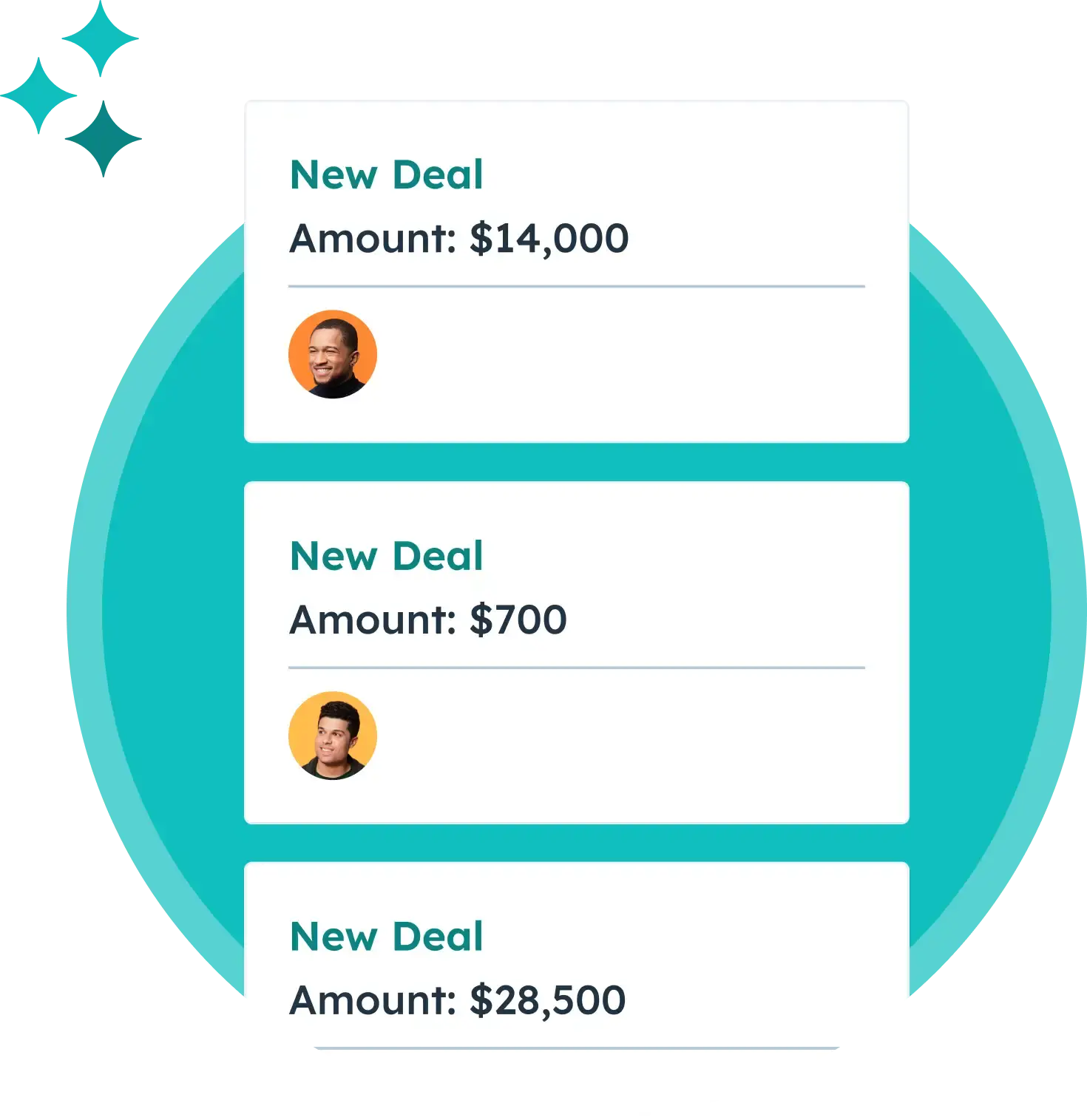
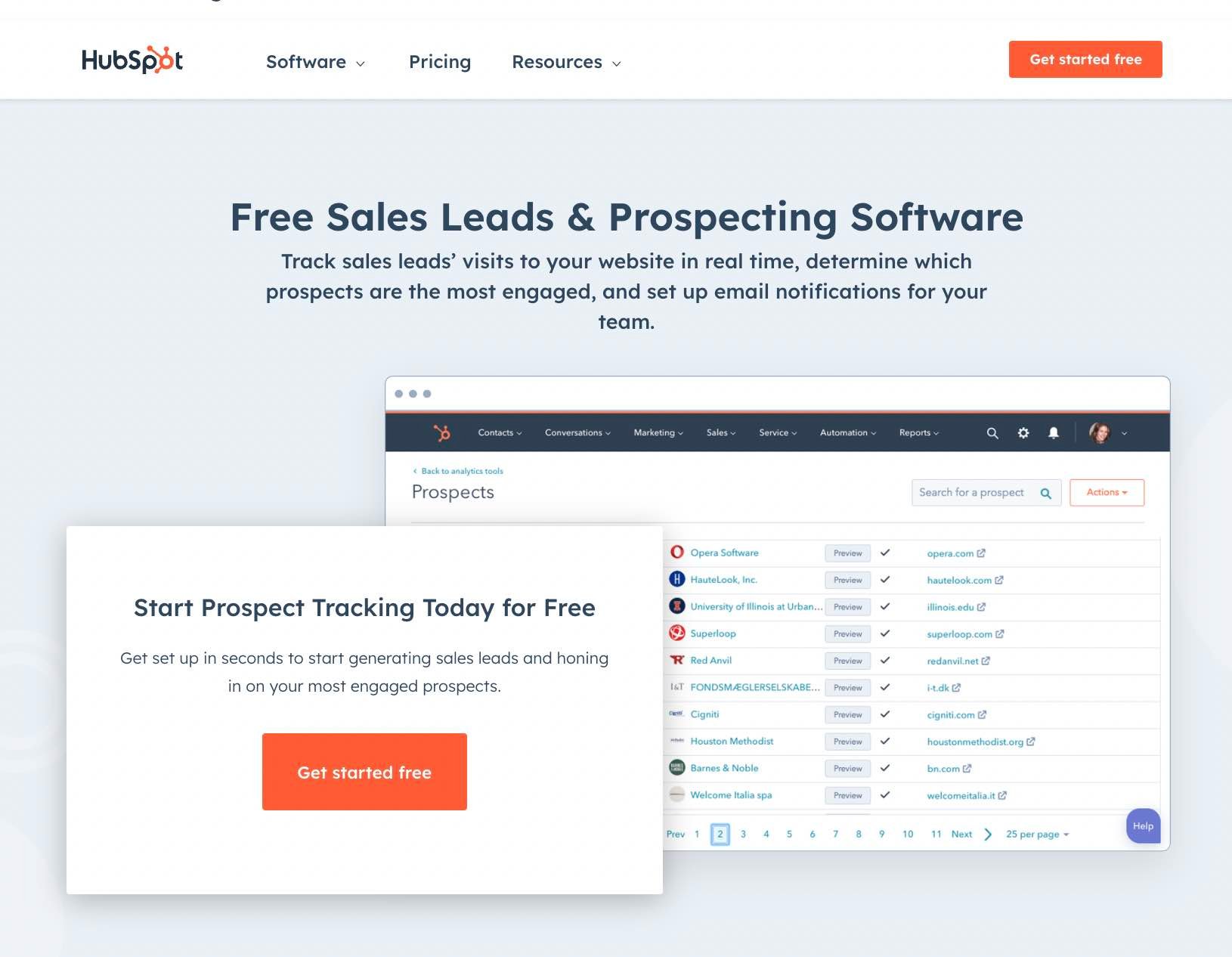



.webp)






![How to Find Almost Anyone’s Email Address, Without Being Creepy [+Expert Tips]](https://53.fs1.hubspotusercontent-na1.net/hubfs/53/132_Find%20Email%20Address.jpg)

